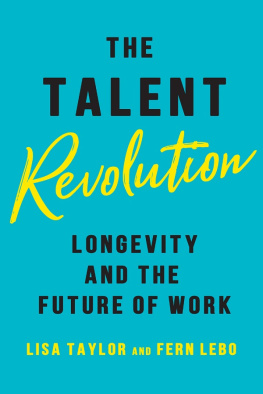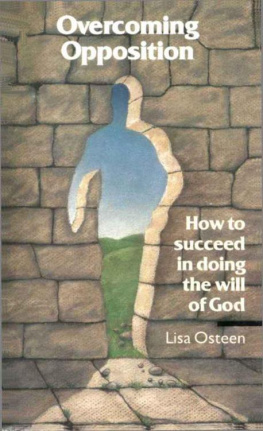Table of Contents
Landmarks
Page List
THE TALENT REVOLUTION
LONGEVITY AND THE FUTURE OF WORK

University of Toronto Press 2019
Rotman-UTP Publishing
Toronto Buffalo London
utorontopress.com
Printed in Canada
eISBN 978-1-4875-1190-6
Printed on acid-free, 100% post-consumer recycled paper with vegetable-based inks.
Library and Archives Canada Cataloguing in Publication
Title: The talent revolution : longevity and the future of work / Lisa Taylor and Fern Lebo
Names: Taylor, Lisa, 1974 June 12, author. | Lebo, Fern, author.
Description: Includes bibliographical references and index.
Identifiers: Canadiana 20189065621 | ISBN 9781487500825 (hardcover)
Subjects: LCSH: Age and employment. | LCSH: Older people Employment. | LCSH: Personnel management.| LCSH: Employment forecasting. | LCSH: Intergenerational relations. | LCSH: Organizational effectiveness.
Classification: LCC HD6279 .T39 2019 | DDC 331.3/98dc23
Lightbulb icon: Victor/iStockphoto
Running icon: bubaone/iStockphoto
University of Toronto Press acknowledges the financial assistance to its publishing program of the Canada Council for the Arts and the Ontario Arts Council, an agency of the Government of Ontario.

CONTENTS
We cannot solve our problems with the same level of thinking that created them.
Albert Einstein
Before tweets and texts and clouds, even before friend was a verb, baby boomers (those born between 1946 and 1964) outnumbered everyone else in the workplace and they were the drivers of commerce. They were the creators, the thinkers, the fixers, and the doers. They were the entrepreneurs, the CEOs, and the presidents. But what used to be isnt any more. Today, this same group of once-energetic capitalists is often portrayed as showing up at work and coasting. Whats more, many managers seem to believe its a kindness to let them do so. Some companies ignore boomers as a rich talent resource and count on the millennials as the only people technically savvy enough to navigate todays technologically confounding workplace. But on close scrutiny, we identify boomers as revolutionaries a population of disruptors that is altering career patterns, creating new expectations, and demanding inclusion. Indeed, this demographic is a revolutionary force one of the five key drivers shaping the future of work. And if, as a CEO, manager, or HR professional, you want to improve productivity, fill the talent pipeline, improve intergenerational effectiveness, and maximize your competitive advantage, boomers are not to be overlooked.
The future of work is an important discussion as we come within striking distance of 2020. Some look forward with anticipation to the countless ways in which work will change over the next decades. Others fear a host of challenges triggered by an aging workforce, intergenerational dynamics, new working models, the need for a living wage, and, of course, artificial intelligence and automation. This book focuses primarily on the role that workplace demographics radically altered by longevity will play in the future of work discussion. It explains how longevity is the catalyst for the talent revolution, and how your organization can capitalize on the opportunity before it.
Every revolution has its own unique set of revolutionaries, trailblazers, casualties, circumstances, influences, and issues, and the talent revolution is no different. It is the logical consequence of a confluence of human realities and innovation that is transforming the world of work. It is nothing less than a major workplace upheaval in need of insightful leadership. The Talent Revolution illuminates what is happening in your workplace today and what is likely to occur as we look toward 2030 and the future of work.
One may well ask: What on earth is going on? Company loyalty has evaporated and the era of staying in the same job for twenty years has long passed. Indeed, it appears that workplace demographics have changed so dramatically that managing the multigenerational workforce is a nightmare. Older workers seem to clog the system and younger workers often quit soon after signing on. Companies are doing their best to urge out boomers while ingratiating themselves to millennials with games rooms, workout spaces, candy carts, and massages. The workplace is in flux and leaders are often at a loss.
What strategies must CEOs undertake to unlock the intergenerational potential within their workforces? What can managers do to supercharge the employees on the payroll? What can HR do to ensure an inclusive culture that motivates excellence at every stage and every age? How can the organization do what it does better, faster, cheaper, and more effectively than the competition? These are a few of the many questions we have been asking in our work with organizations big and small across North America. The book you are reading flows from what we have learned and the answers we have found. While not all our suggestions are universally applicable, the solutions we offer, the models we present, and the strategies we suggest have been battle-tested in the field, and they may provide the answers you seek. Thats why weve written The Talent Revolution to provide new insights and strategies for turning an aging workforce into a competitive advantage.
The topics of workplace change, shifting employment models, and labor strategy are hot, and they will undoubtedly trigger countless studies by a range of academics and corporate analysts, providing more than enough material to fill volumes for years to come. Our concern is more practical and immediate. As business practitioners focused on supercharging workforces and maximizing talent equity, we dig down and look more closely at the human element now. Call us unorthodox, but we see demographics as the single greatest competitive opportunity on which smart organizations must capitalize. Furthermore, we suggest it demands urgent attention.
The workplace is a different arena than it was even a decade ago. Complicated times, complex technology, and thorny human issues have coalesced in recent years to create what often feels like a chaotic state of affairs, one that is as difficult to plan for as it is to characterize. But we see patterns in the chaos patterns we have orga-nized into a practical model so leaders can make sense of the dynamics now in play and effectively modify workforce strategies to capitalize on the changes they are experiencing.
We contend that the talent revolution is underway. Our work, our reading of the literature, and our own proprietary research and analysis leads us to this conclusion: the future of work is being shaped by technological and talent-driven innovation, and it can best be understood by examining five significant drivers drivers that individually and collectively are transforming the way work gets done. We believe that the structures and cultural attitudes at play in most organizations are outdated and counterproductive, that they fail to take advantage of the intellectual capital currently within their ranks, that organizations can thrive with new thinking, innovative strategies, and new models, and that an attitudinal and structural reset will propel early adopters of the new models ahead of their competition. We believe this because it is already happening with our clients.















